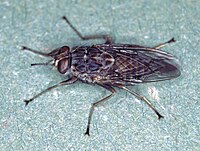
Photo from wikipedia
Abstract During larval rearing of Culicoides peregrinus Kieffer (Diptera: Ceratopogonidae) it was obligatory to add a small quantity of mud from larval habitat to nutrient broth in culture plates. This… Click to show full abstract
Abstract During larval rearing of Culicoides peregrinus Kieffer (Diptera: Ceratopogonidae) it was obligatory to add a small quantity of mud from larval habitat to nutrient broth in culture plates. This initiated microbial growth in rearing plates which facilitated growth and development of immature. The primary aim was to enumerate gut microbial communities across the different life stages of C. peregrinus. Amplicon sequencing of the V3–V4 hypervariable region (16S rDNA) was done on Illumina Miseq platform to detect gut bacterial communities at different life stages, while ITS regions (18S rRNA) were targeted for fungal communities of the 4th instar larvae. The major findings were: 1) Phylum Proteobacteria and Firmicutes were the most abundant throughout the life stages, along with the highest bacterial alpha diversity in the egg, 2) bacterial compositions were similar to laboratory reared and field collected adults, and 3) abundant fungal phyla associated with the larval gut were Ascomycota and Basidiomycota. Furthermore, analyses of the gut microbiome with METAGENassist might be indicative of their likely function in the natural habitat. Abundant gut-associated bacteria and/or fungal genera detected in the present study could be used as dietary supplements to establish laboratory colonies for further vectorial research. While, individual roles of the bacteria or fungi in paratransgenesis are warned for their possible utilization to frame the management strategy in upcoming works. Graphical Abstract
Journal Title: Journal of Medical Entomology
Year Published: 2023
Link to full text (if available)
Share on Social Media: Sign Up to like & get
recommendations!